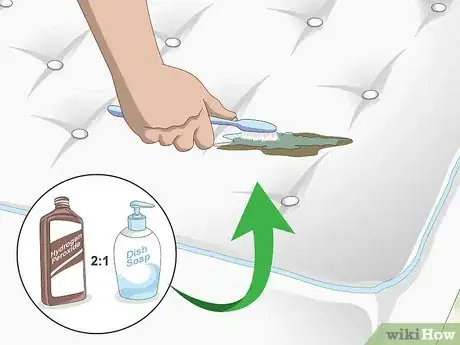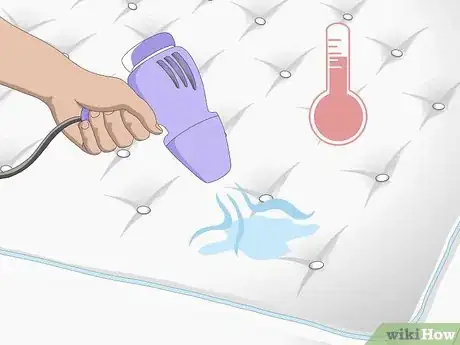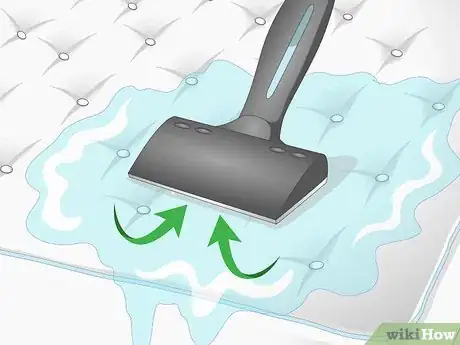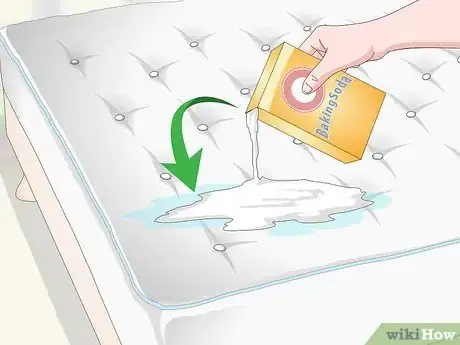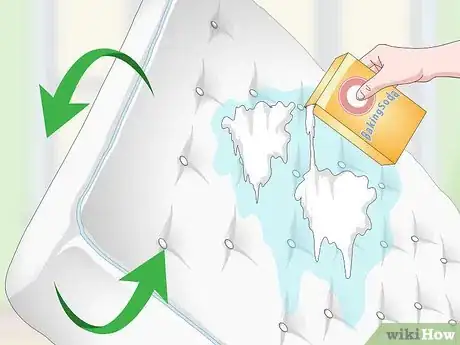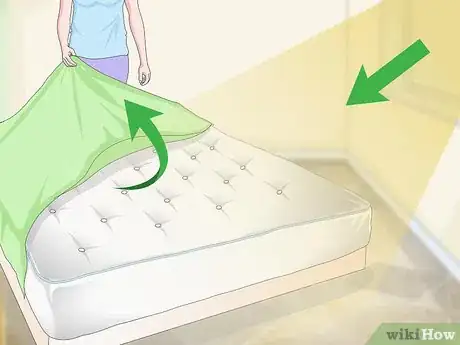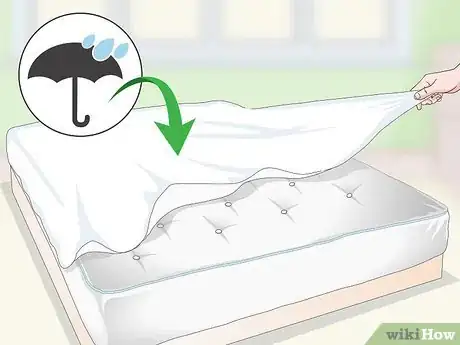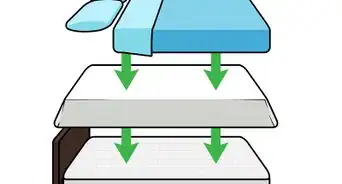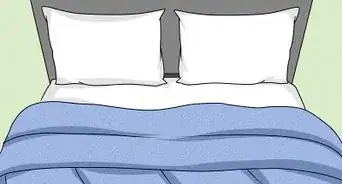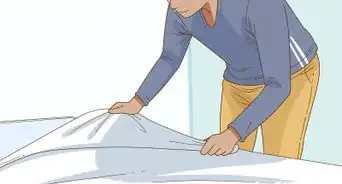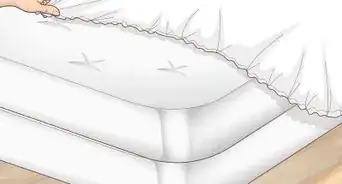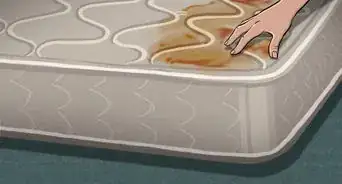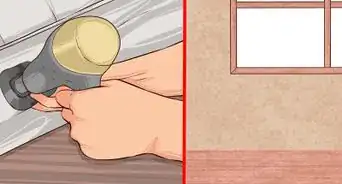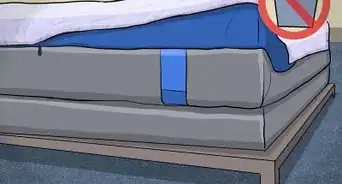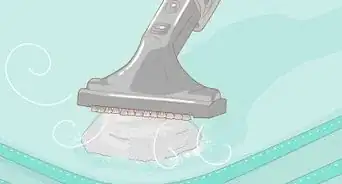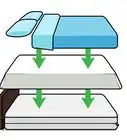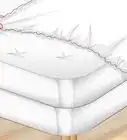This article was co-authored by Kadi Dulude and by wikiHow staff writer, Sophia Latorre. Kadi Dulude is a House Cleaning Professional and the Owner of Wizard of Homes, a New York City-based cleaning company. Kadi has over 10 years of experience and manages a team of over 90 registered cleaning professionals. Her cleaning advice has been featured in Architectural Digest and New York Magazine.
This article has been viewed 185,281 times.
A wet mattress is not only a headache, it breeds mold and mildew! Don’t worry though, you can dry your mattress easily with a few simple steps, regardless of how it got wet. Utilize direct sunlight and air circulation to dry your mattress as quickly as possible. Then, put a waterproof mattress cover on so that the next time the mattress gets wet you can simply toss the cover in the washing machine.
Steps
Removing Moisture
-
1Blot the area with clean, dry towels. Once a spill or leak has occurred, immediately press a clean, dry towel into the mattress to absorb the liquid. Replace your towel once it becomes soaked. Try to get as much of the liquid up as possible.[1]
-
2Treat any stains. If your mattress is wet from bodily fluids, like urine or blood, you’ll need to use an enzyme cleaner. Other stains can be treated with a mixture of 2 parts hydrogen peroxide to 1 part liquid dishwashing soap. Brush the stain remover into the mattress with a toothbrush, then wipe it up after 5 minutes with a cool, damp cloth.[2]EXPERT TIPKadi Dulude is a House Cleaning Professional and the Owner of Wizard of Homes, a New York City-based cleaning company. Kadi has over 10 years of experience and manages a team of over 90 registered cleaning professionals. Her cleaning advice has been featured in Architectural Digest and New York Magazine.House Cleaning Professional

 Kadi Dulude
Kadi Dulude
House Cleaning ProfessionalExpert Trick: For a quick fix, take everything off your mattress and then place towels on the wet spot. Then stand on the towel, pressing it into the mattress, and shuffle around a bit to soak up as much liquid as possible. Let the mattress dry with no sheets or blankets on it.
Advertisement -
3Dry small spots with a hairdryer. If only a small amount of liquid got on the mattress, like if you spilled a glass of water, you can quickly dry it with a hairdryer. Aim the hairdryer at the wet spot and use a warm, not hot, setting. Keep the hairdryer moving for best results.[3]
-
4Use a wet/dry vacuum to soak up excess liquid. If rain blew in from the window, for example, a portion of your mattress may be soaked. Turn on a wet/dry vacuum and run the nozzle over the wet parts of the mattress in long, even strokes to suck up the liquid.[4]
- Disinfect the vacuum nozzle first, as you don’t want to touch your mattress with a nozzle that’s been stuck into cobweb-filled corners of the garage. Simply wipe it with an antibacterial wipe, inside and out, and let it dry.
-
5Press clean kitty litter into the mattress to absorb liquid. If your mattress was moved during a rainstorm, for instance, it’s bound to be pretty wet. Spread a layer of clean kitty litter over the wet areas of the mattress. Then, cover the kitty litter with a towel and firmly press the kitty litter into the mattress. Vacuum up the kitty litter with a wet/dry vacuum.[5]
- If the mattress is still wet, spread a fresh layer of kitty litter on the mattress and allow it to sit for 1 to 2 hours. Then, vacuum it up.
-
6Dry a soaked mattress in direct sunlight, if possible. After you’ve soaked up as much of the liquid as possible, take the mattress outdoors and set it in the sunlight. Choose the hottest, sunniest spot on your property. Be sure to spread plastic sheeting or an old blanket beneath the mattress so it doesn’t get dirty.[6]
- Sunlight has the added benefit of killing bacteria in your mattress, as well.
-
7Provide plenty of air circulation if drying indoors. Open as many windows as possible to get the air moving around the mattress. If both sides are wet, stand it on one end or lean it against a solid surface so air can flow freely around it. Set up a fan and/or a dehumidifier, depending on what you have handy. Direct the fan at the mattress to increase the air circulation.[7]
-
8Expect to wait a few hours. Unfortunately, time is essential for drying a mattress. If the mattress is soaked, like from a ceiling leak, it’s best to make alternative sleeping arrangements for the night, as it may take up to 24 hours to fully dry. Covering the mattress with sheets and bedding when it’s wet will lead to mold and mildew growth, which is hazardous to your health.[8]
Extending the Life of the Mattress
-
1Sprinkle baking soda over the mattress. Plain baking soda will absorb any lingering moisture as well as unpleasant odors from your mattress. Sprinkle your entire mattress with a light layer of baking soda. Ensure the whole mattress is evenly coated.[9]
-
2Vacuum it up after at least 30 minutes. If you’re in a hurry, wait at least 30 minutes before vacuuming up the baking soda. If you have more time, you can let the baking soda sit on the mattress for up to 24 hours. Use the upholstery attachment on your vacuum, if applicable, to vacuum up all the baking soda when you’re ready.[10]
-
3Repeat on the other side. If you have a double-sided mattress that you flip on occasion, be sure to repeat the process on the other side. Sprinkle baking soda over the mattress, let it sit for at least 30 minutes, then vacuum it up with an upholstery attachment.[11]
-
4Air out your mattress every few months. If you’ll be away from your home for a few days, use the opportunity to air out your mattress. Strip all the sheets and bedding and allow the mattress to air out while you’re gone. Allowing sunlight into the room can kill bacteria in the mattress, so leave the shades open if possible.[12]
-
5Use a waterproof mattress protector. Not only does a waterproof mattress protector keep spills from seeping through to your mattress, it also prevents the mattress from absorbing sweat, dirt, oil, and germs! Once your mattress is clean and dry, cover it with a nontoxic, hypoallergenic, waterproof mattress protector to ensure you don’t have to worry about a wet mattress again.[13]
Warnings
References
- ↑ https://www.cleanandscentsible.com/how-to-clean-your-mattress-spring/
- ↑ http://cleanmyspace.com/how-to-clean-deodorize-and-care-for-a-mattress/
- ↑ http://www.esquire.com/style/advice/a42934/clean-mattress/
- ↑ https://www.tuftandneedle.com/resources/mattress-cleaning/
- ↑ https://www.furniture.com/mattress/guide/faq/how-to-dry-a-mattress
- ↑ https://www.cleanandscentsible.com/how-to-clean-your-mattress-spring/
- ↑ http://www.esquire.com/style/advice/a42934/clean-mattress/
- ↑ http://www.esquire.com/style/advice/a42934/clean-mattress/
- ↑ https://www.cleanandscentsible.com/how-to-clean-your-mattress-spring/
- ↑ https://www.cleanandscentsible.com/how-to-clean-your-mattress-spring/
- ↑ https://www.cleanandscentsible.com/how-to-clean-your-mattress-spring/
- ↑ https://www.cleanandscentsible.com/how-to-clean-your-mattress-spring/
- ↑ https://www.healthychild.com/waterproof-mattress-protectors/
- ↑ https://www.furniture.com/mattress/guide/faq/how-to-dry-a-mattress
- ↑ http://www.esquire.com/style/advice/a42934/clean-mattress/
About This Article
If you need to dry a mattress, blot the area with a clean, dry towel as quickly as you can after the spill or leak occurs. Once the towel becomes wet, replace it with another until you’ve soaked up as much of the liquid as you can. If the mattress is stained, clean the spot with a mixture of hydrogen peroxide and dish soap, or use an enzymatic cleaner if the stain is from bodily fluids. Once you’ve finished that, either blow dry the area if the stain is small, or use a wet/dry vacuum if the mattress is saturated. Let the mattress dry in a sunny spot with good air circulation. For tips on how to use baking soda to remove any unpleasant odors, keep reading!

